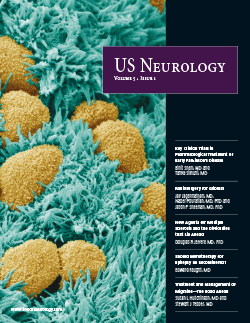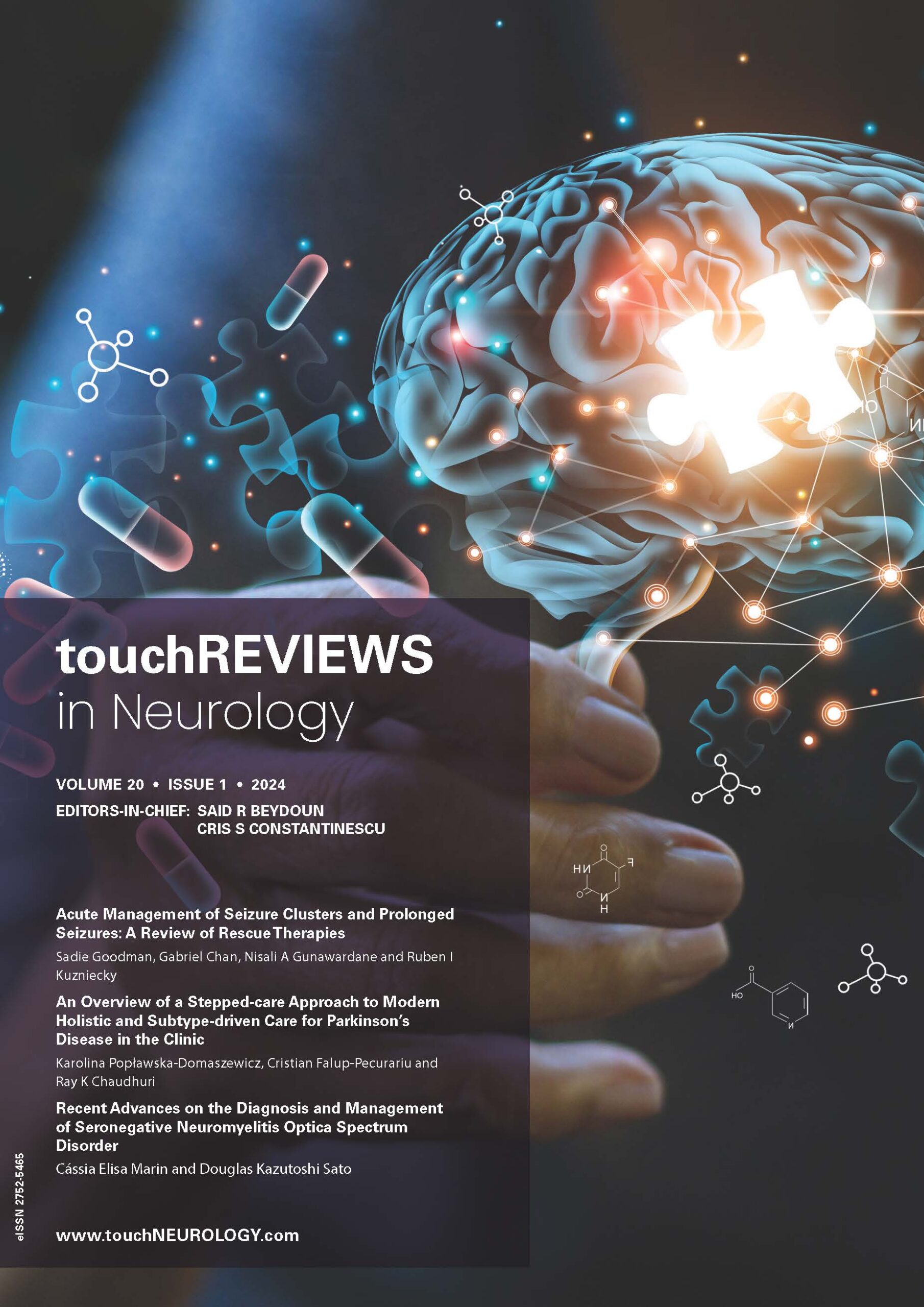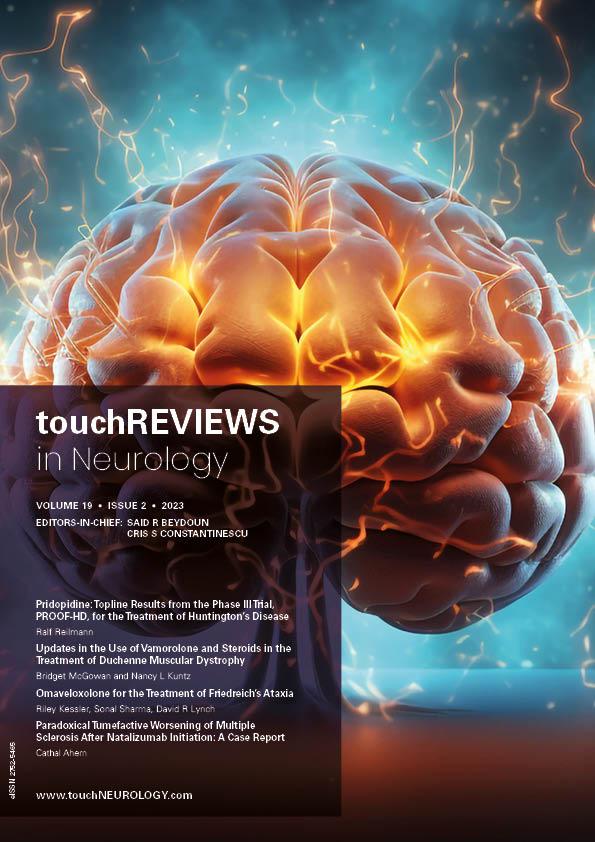
US NEUROLOGY – VOLUME 5 ISSUE 1 – SPRING 2009
Foreword
July 2009 saw the 40th anniversary of the first human landing on the Moon, a feat of American engineering and scientific prowess that is mind-boggling, even—or especially—in retrospect. It was accomplished in under 10 years from conception to completion—less time than it takes to bring many drugs to market. For those who watched Neil Armstrong […]
Current Issues
As readers of this publication are certainly aware, mental disorders impose very considerable costs on society. This is due to many factors, including their episodic/chronic nature, their relatively early age at onset, and the highly disabling nature of inadequately treated mental illness.
Neurodegenerative Diseases
Numerous clinical trials are under way to evaluate therapeutic approaches to stop the progression of Alzheimer’s disease (AD). Despite the significant efforts toward, for example, clearance of amyloid plaques by vaccination therapies, these approaches may still fall short of cognitive recovery in the AD population as they do not directly focus on the regeneration of […]
Alzheimer’s disease (AD) is the most common form of dementia, and worldwide affects 20–30 million individuals over 60 years of age. In 1907 Alois Alzheimer first described AD following an autopsy on the brain of a 55-year-old women who had died following progressive mental deterioration, increasing confusion, and memory loss.
Alzheimer’s disease (AD), described for the first time in 1906 by Alois Alzheimer, is a neurodegenerative disease and the most frequent cause of dementia worldwide. The major neuropathological hallmarks of the disease are loss of neurons and synapses, and senile plaques (extracellular aggregates primarily composed of β-amyloid; Aβ) and neurofibrillary tangles (aggregates of hyperphosphorylated forms […]
People diagnosed with Parkinson’s disease (PD) are presented with unique challenges. It requires effort and tenacity to understand and manage a chronic, progressive condition. Those living with PD have important questions to be answered and concerns to be addressed at various points on their journey. For instance, it is necessary for individuals to know where […]
Parkinson’s disease (PD) is the second most common neurodegenerative disease and affects more than one million people in the US.1 The cause of PD is unknown, but it involves the loss of dopaminergic neurons in the substantia nigra pars compacta of the midbrain. Clinically, PD is characterized by the triad of rigidity, bradykinesia, and rest […]
Performing two tasks simultaneously (dual task performance) is a frequent activity in human life. However, performing dual tasks can be difficult. When people attempt to perform dual tasks, performance is generally impaired, manifested by increased errors or reaction times compared with when the tasks are performed individually. Such a deterioration of performance is defined as […]
Parkinson’s disease (PD) is a common neurodegenerative disorder characterized by dopaminergic neuronal loss in the substantia nigra and other brain areas. Despite the vast majority of cases being sporadic, at least six genes have been identified so far that are responsible for autosomal dominant or recessive forms of parkinsonism. The PARK6 locus was mapped to […]
Brain Trauma
Stroke is the leading cause of disability in the US and is a major global health problem. It has been identified as one of the largest causes of lost productivity in late adulthood. The multiple life-altering complications that result from stroke—such as paresis, mood disorders, aphasia, cognitive deficits, dysarthria, dysphagia, and visual disturbances—may be confounded […]
Stroke is a major public health burden worldwide that demands continued research to improve treatment and prevention. However, stroke presents a number of practical and ethical challenges to research due to its unpredictability, apoplectic onset, and potential to render individuals incapable of providing informed consent. Disagreements regarding appropriate safeguards for subjects are as old as […]
In spite of their lack of propensity for hematogenous dissemination, the prognosis for adults afflicted with gliomas has not substantially improved, even with advances in neurosurgery, neuro-oncology, and radiation oncology.1,2 Although microsurgical resection remains the initial treatment of choice for most gliomas, these tumors may grow in eloquent areas, making gross total resection impossible. They […]
Multiple Sclerosis
Persons with multiple sclerosis (PwMS) frequently experience limitations of ambulation in the course of their disease. Not surprisingly, in recent surveys PwMS considered lower extremity function as one of the most important bodily functions,1 and ranked mobility limitations as the most important factor affecting their quality of life.2 The impact of MS on ambulation is […]
The future of therapeutic alternatives in multiple sclerosis (MS) at first glance appears brighter now than at any time in the history of modern MS therapeutics. A host of new agents, both oral and intravenous, are in various stages of development. Patients and physicians alike have been clamoring for oral agents and drugs with greater […]
Neuromyelitis Optica
Neuromyelitis optica (NMO, or Devic’s disease) is an autoimmune inflammatory disease of the central nervous system (CNS) that is typically associated with severe attacks of optic neuritis and myelitis and characteristically spares the brain early in the disease course. Although historically believed to be distinct from multiple sclerosis (MS) in that it presented with simultaneous […]
Epilepsy
For the past 30 years, a dogma of epilepsy treatment has been to start with monotherapy.1 This still makes sense for several reasons: cost, lower risk of side effects, better compliance, and avoidance of pharmacokinetic (PK) and pharmacodynamic (PD) drug interactions.2 Furthermore, data from many studies indicate that initial monotherapy produces seizure freedom in 50–70% […]
Epilepsy is a term used to describe over 40 different human seizure disorders that vary in clinical and electroencephalographic (EEG) characteristics. It is one of the most common neurological disorders and occurs in about 1% of the population, independent of geography, ethnicity, or gender.1 Seizures occur when the brain is disrupted by abnormal neuronal activity. […]
Headache
Numerous ‘tools’ have been developed for clinicians and patients that elucidate important elements of migraine diagnosis and management. Just as the stethoscope captures the dynamics of the working heart, migraine tools are an external verification of the migraineur’s level of pain and disability. Properly utilized, ‘migraine tools’ have the potential to: improve communication between patient […]
Acute Treatment of Migraine When the American Headache Society (AHS) recently celebrated its 50th anniversary, a poll was taken among the members asking them to vote on the most important achievement in the field of headache in the last 50 years. The winner was Dr Pat Humphrey and the discovery of sumatriptan.
The second edition of the headache classification from the International Headache Society (IHS) has defined a new primary headache grouping named the trigemino-autonomic cephalgias (TAC).1 All of these headache syndromes have two features in common: relatively short-lasting, unilateral, severe headache attacks, and, typically, accompanying cranial autonomic symptoms. These autonomic symptoms occur on the side of […]
Imaging
Perfusion is defined as the steady-state delivery of nutrients and oxygen via blood to tissue per unit volume or mass and is typically measured in milliliters per 100g of tissue per minute.1 Because blood flow brings crucial nutrients, and because it is disturbed in many disease processes, monitoring of this key physiological parameter can often […]

Trending Topic
Amyotrophic lateral sclerosis (ALS) is characterized by the degeneration of both upper and lower motor neurons, which ultimately leads to muscle weakness, atrophy, spasticity and contractures.1 ALS typically manifests in the 50–60 years age range, although familial cases may present in late adolescence or early adulthood.2 The time from the first symptom to diagnosis is approximately 10–16 […]
Journal Archive
touchREVIEWS in Neurology is a peer-reviewed, free-to-access, bi-annual neurology journal comprising review articles, case reports, practice guides, theoretical discussions, and original research. It features balanced and comprehensive articles written by leading authorities, addressing the most important and salient developments in the field of neurology.
Latest articles videos and clinical updates - straight to your inbox
Log into your Touch Account
Earn and track your CME credits on the go, save articles for later, and follow the latest congress coverage.
Register now for FREE Access
Register for free to hear about the latest expert-led education, peer-reviewed articles, conference highlights, and innovative CME activities.
Sign up with an Email
Or use a Social Account.
This Functionality is for
Members Only
Explore the latest in medical education and stay current in your field. Create a free account to track your learning.






